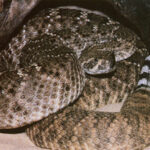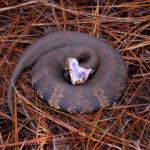When most people think of hiking in the woods, their main concerns tend to be about things like venomous snakes and bears. My biggest fear while hiking in the summer comes in a much smaller package. The thought of tiny seed ticks has been enough to keep me inside on more than one occasion, and the reality of seed ticks has caused me to abandon a hike mid-trail more often than I’d like to admit. In fact, if you mention the phrase “seed tick” to even the most hardened of woodsman you’ll probably be on the receiving end of stories that will make your blood run cold.
So what is this small animal that can cause so much terror?
What are Seed Ticks?
Seed ticks are not a separate species of tick, but rather the larval stage all tick species. Seed ticks are exceedingly small, in most cases no bigger than the period at the end of this sentence. It’s not the size of the seed ticks that make them a nuisance, though; it’s the numbers. Because seed ticks are newly hatched from eggs, they don’t travel and disperse as much as adult ticks do. They tend to stay where the eggs are laid. This wouldn’t be such a big problem if ticks didn’t typically lay eggs in the thousands.
Though it may seem like an exaggeration, a person can easily wander into a cache of seed ticks and end up crawling with literally hundreds, if not thousands, of tiny ticks. The sheer number of seed ticks is what makes them such a nuisance.
Even though they are much smaller than adults, seed ticks can still bite and cause the same sort of itchy bumps as full grown ticks. After biting, larval ticks will fill themselves up with blood and detach. Once they’ve done this, the ticks will molt and transform into their next developmental stage on the way to becoming fully adult. If you are unlucky enough to be bitten, I guess you can feel good about becoming part of a tick’s coming-of-age story.
One bright side to seed ticks (if there is a bright side) is that they are less likely to carry diseases like Rocky Mountain Spotted Fever, Ehrlichiosis and Lyme Disease. This is because seed ticks, being newly hatched, are less likely to have bitten anything before you. This does not mean that it is impossible for seed ticks to transmit tick-borne illnesses, though, so always keep an eye out for suspicious symptoms. They also take a little longer to attach than an adult tick, so even if you are covered in seed ticks, you may not be bitten.
How to Avoid Seed Ticks
It’s not always easy or even possible to avoid seed ticks completely. This should not, however, deter you from enjoying the great outdoors.
Keep in mind that seed ticks in some areas are more prevalent at different times of the year. Here in southwestern Missouri, for example, seed ticks are especially noticeable in late summer. This is actually a good thing, because the Ozarks’ late summer humidity keeps most people inside anyway. Ask around to determine when ticks are worst in your area.
Check yourself for ticks often, and wear light colored clothing to make them more apparent.
Some will argue that chemical pesticides (like those that contain Deet) are effective at repelling seed ticks. In my experience this has not been the case, but bug spray may prove effective for some. I will say that chemical insect repellent works for keeping adult ticks at bay. Whether you use insect repellant or not will probably depend on your comfort level with spraying chemicals onto your skin and clothing.
One nearly fool-proof way to keep seed ticks from reaching your skin is to wear long pants tucked into your boots. For added security, it doesn’t hurt to wrap some duct tape around your boots where the pants have been tucked in. You won’t be setting any fashion trends, but you will decrease the likelihood of seed ticks getting into your shoes.
Sources:
University of Missouri Extension: Ticks
Urban Integrated Pest Management: Ticks
Personal Experience






